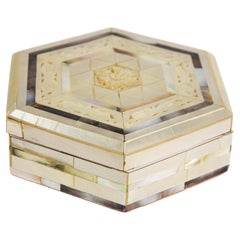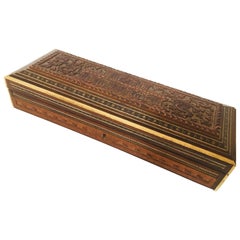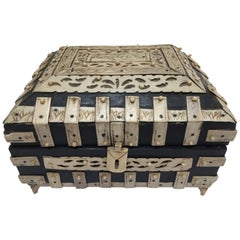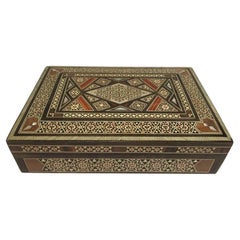Want more images or videos?
Request additional images or videos from the seller
1 of 9
Syrian Mother-of-Pearl Bone Inlay Box
$1,200List Price
About the Item
- Dimensions:Height: 3.5 in (8.89 cm)Width: 12.5 in (31.75 cm)Depth: 8.75 in (22.23 cm)
- Style:Islamic (In the Style Of)
- Materials and Techniques:
- Place of Origin:
- Period:
- Date of Manufacture:1950
- Condition:Wear consistent with age and use.
- Seller Location:Moreno Valley, CA
- Reference Number:Seller: BSY181stDibs: LU906811139591
About the Seller
5.0
Platinum Seller
Premium sellers with a 4.7+ rating and 24-hour response times
1stDibs seller since 2011
3,189 sales on 1stDibs
Typical response time: 1 hour
Authenticity Guarantee
In the unlikely event there’s an issue with an item’s authenticity, contact us within 1 year for a full refund. DetailsMoney-Back Guarantee
If your item is not as described, is damaged in transit, or does not arrive, contact us within 7 days for a full refund. Details24-Hour Cancellation
You have a 24-hour grace period in which to reconsider your purchase, with no questions asked.Vetted Professional Sellers
Our world-class sellers must adhere to strict standards for service and quality, maintaining the integrity of our listings.Price-Match Guarantee
If you find that a seller listed the same item for a lower price elsewhere, we’ll match it.Trusted Global Delivery
Our best-in-class carrier network provides specialized shipping options worldwide, including custom delivery.You May Also Like
Indochinese Box in Wood and Mother of Pearl circa 1900
Located in Beuzevillette, FR
Nice wooden and mother-of-pearl box from the 1900s. The mother-of-pearl inlays form plant motifs (flowers and foliage), incised to give volume to the different parts. It closes with ...
Category
Antique Late 19th Century Asian Decorative Boxes
Materials
Wood
Provincial Chinese Wooden Box with Bone Chopstick Handles
Located in Chicago, IL
A narrow wooden box with a sliding lid and a pair of carved bone chopstick handles with contrasting dark inlay at the ends. The bone handles were likely originally affixed to chopsti...
Category
Antique Mid-19th Century Chinese Qing More Asian Art, Objects and Furniture
Materials
Wood, Bone
19th Century Walnut Box With Bone and Mother Of Pearl Inlay
Located in Stamford, CT
19th century walnut box with bone and mother of pearl inlay, whaler made. This beautifully hand crafted box would have been made during the long voyage of a whaling ship. The star in...
Category
Antique Late 19th Century American Folk Art Decorative Boxes
Materials
Bone, Mother-of-Pearl, Walnut
16th-Century Indo-Portuguese Colonial Mother-of-pearl Gujarat Casket
Located in Amsterdam, NL
An exceptional Indo-Portuguese colonial mother-of-pearl veneered casket with silver mounts
India, Gujarat, 2nd half of the 16th century, the silver mounts Goa or probably Lisbon
Measures: H. 16 x W. 24.6 x D. 16.1 cm
An exceptional Gujarati casket with a rectangular box and truncated pyramidal lid (with slopes on each side and a flat top) made from exotic wood, probably teak (Tectona grandis), covered with a mother-of-pearl mosaic. The tesserae, cut from the shell of the green turban sea snail (Turbo marmoratus, a marine gastropod) in the shape of fish scales, are pinned to the wooden structure with silver ball-headed nails. The casket is set on bracket feet on the corners. The masterfully engraved decoration of the silver mounts follows the most refined and erudite Mannerist repertoire of rinceaux and ferroneries dating from the mid-16th century. The high quality and refinement of the silver mounts and, likewise, the silver nails that replaced the original brass pins used to hold the mother-of-pearl tesserae in place indicate the work of a silversmith probably working in Lisbon in the second half of the 16th century.
The Indian origin of this production, namely from Cambay (Khambhat) and Surat in the present state of Gujarat in north India, is, as for the last three decades, consensual and fully demonstrated, not only by documentary and literary evidence - such as descriptions, travelogues and contemporary archival documentation - but also by the survival in situ of 16th-century wooden structures covered in mother-of-pearl tesserae. A fine example is a canopy decorating the tomb (dargah) of the Sufi saint, Sheik Salim Chisti (1478-1572) in Fatehpur Sikri in Agra district in the state of Uttar Pradesh, north India. This is an artistic production, geometric in character and Islamic in nature, where usually the mother-of-pearl tesserae form complex designs of fish scales or, similar to the dishes also made using the same technique, with the thin brass sheets and pins, stylized lotus flowers. The truncated pyramidal shape corresponds, like their contemporary tortoiseshell counterparts also made in Gujarat, to a piece of furniture used in the Indian subcontinent within the Islamic world prior to the arrival of the first Portuguese. This shape, in fact, is very old and peculiar to East-Asian caskets, chests or boxes used to contain and protect Buddhist texts, the sutras.
A similar chest is the famous and large reliquary chest from Lisbon cathedral that once contained the relics of the city's patron saint, Saint Vincent. Both match in shape, having the same kind of socle or pedestal and bracket feet, and in their engraved silver mountings, featuring the same type of refined, erudite decoration. Their differences lie in the silver borders that frame the entire length of the edges of the chest (both the box and the lid), pinned with silver nails, and on the lock plate, shaped like a coat of arms in the Lisbon example. Given the exceptional dimensions of the reliquary casket...
Category
Antique 16th Century Indian Jewelry Boxes
Materials
Silver
$272,054
Free Shipping
H 6.3 in W 9.69 in D 6.34 in
Taraceada Box with Rabbits, with Inlays, Mother Pearl, Bone, Faux Totrtoiseshell
By Alfonso Marina
Located in Bosques de las Lomas, MX
Very beautiful and detailed decorative box. Each part that conforms this piece is a jewel by itself: brass inlays, mother pearl, sgraffito bone and faux tortoiseshell.
Category
21st Century and Contemporary Mexican Decorative Boxes
Materials
Cedar
$9,390 / item
H 4.75 in W 14.75 in D 14.75 in
18th century Dutch-Colonial ‘Vizagapatam’ pen-engraved bone inlaid ebony box
Located in Amsterdam, NL
A large Indian Colonial ‘Vizagapatam’ pen-engraved bone inlaid ebony box
Masulipatnam or Vizagapatam, 2nd half 18th century
H. 10.8 x W. 47 x D. 34 cm
...
Category
Antique Late 18th Century Indian Dutch Colonial More Asian Art, Objects ...
Materials
Bone, Ebony
$41,399
Free Shipping
H 4.26 in W 18.51 in D 13.39 in
English Petite Mother-of-Pearl Inlay Box, c. 1900
Located in Chicago, IL
This late 19th century English trinket box has an elegant design of lacquered papier-mâché with mother-of-pearl inlay. The inlaid decoration depicts a spray of various flowers which ...
Category
Antique Late 19th Century British Victorian Snuff Boxes and Tobacco Boxes
Materials
Mother-of-Pearl, Wood, Lacquer
Brass and Mother-of-Pearl Inlay Round Box
Located in Los Angeles, CA
Elegant round decorative box featuring a brass frame with intricate mother-of-pearl inlay arranged in a diamond pattern across the lid and sides. The luminous iridescence of the shel...
Category
Vintage 1980s Italian Modern Decorative Boxes
Materials
Mother-of-Pearl
Geometric Mother-of-Pearl and Horn Inlay Decorative Box
Located in Los Angeles, CA
This elegant rectangular box showcases a striking geometric design created from alternating strips of dark horn and shimmering mother-of-pearl inlay. The pattern forms a mesmerizing ...
Category
Vintage 1960s Italian Modern Decorative Boxes
Materials
Mother-of-Pearl
Colonial Islamic Arabian Market Jewelry Box, 18th Century, India/Malabar Coast
Located in Amsterdam, NL
AN INDIAN ROSEWOOD AND EBONY BRASS MOUNTED BOX FOR THE ISLAMIC MARKET
Malabar Coast, 18th century
With a large drawer with several compartm...
Category
Antique 18th Century Indian Islamic Jewelry Boxes
Materials
Brass
$10,054
Free Shipping
H 4.85 in W 10.4 in D 7.68 in
More From This Seller
View AllHandcrafted White Mother of Pearl Inlaid Moorish Octagonal Box
Located in Moreno Valley, CA
Exquisite handcrafted white mother of pearl inlaid and hand carved lidded box.
Small octagonal Anglo Indian decorative box intricately decorated with Moorish motif designs which hav...
Category
Mid-20th Century Indian Moorish Decorative Boxes
Materials
Shell, Fruitwood, Abalone, Mother-of-Pearl
Fine Antique Anglo Indian Bombay Inlay Box
By Rajhastani
Located in Moreno Valley, CA
Fine antique Anglo-Indian hand carved wooden jewelry box inlaid.
Nice Indian Mughal pen box handcrafted in very fine Sadeli micro mosaic...
Category
Antique Late 19th Century Indian Islamic Decorative Boxes
Materials
Wood
Anglo-Indian Vizagapatam Bombay Mughal Style Footed Box With Bone Overlay
Located in Moreno Valley, CA
Nice and unusual Indian Mughal style large decorative box, filigree and carved horn.
Anglo-Indian footed domed box with exceptional engraved details throughout with filigree and carved veneered bone plaques with arabesque carving.
Vizagapatam, late 19th century.
History of the Anglo-Indian Boxes
Beginning in the early part of the 18th century, Indian artisans made what came to be known as Anglo-Indian boxes for the English residents living in India, who eventually brought or sent them back to England. At the beginning of the 19th century, India began exporting these boxes commercially, although not in any significant numbers until the 1850s. People valued them so highly that manufacturers of tins copied the designs on them in the late 19th and early 20th century.
Anglo-Indian boxes fall into four groups: Rosewood or ebony boxes inlaid;
sandalwood boxes veneered; sandalwood boxes covered with Sadeli mosaic; and carved boxes often combined with Sadeli mosaic/
The first two categories came from Vizagapatam in East India while the last two came from Bombay in West India.
English traders discovered the rich woods and intricate workmanship of Indian artisans, so colonial government officials began to recognize the work of the Indian artists and craftsmen as a source for satisfying the need for furniture and boxes, which would both serve to enhance English households in India. This gave rise to the cabinetmaking workshops in Vizagapatam between Calcutta and Madras.
Craftsmen made the first boxes to be decorated with Sadeli mosaic of rosewood or ebony, incised to give further definition to the decoration, directly inlaid into the wood. The shape of the early boxes was either sloping at the front with a flatter section at the back, reminiscent of English writing slopes, or rectangular. Artisans inlaid the borders with stylized floral scrolls and the centers with a single floral motif following a circular or oval symmetrical or asymmetrical pattern. The edging was ornamental and protective, both helped protect the end grain against the weather.
Made in Vizagapatam, situated on the south east coast of India, near Madras
These exotic boxes...
Category
Antique Late 19th Century Indian Anglo Raj Decorative Boxes
Materials
Wood
Middle Eastern Syrian Inlay Jewelry Box
Located in Moreno Valley, CA
Exquisite Middle Eastern Syrian inlay jewelry box intricately inlaid with Moorish motif designs which have been painstakingly inlaid micro mosaic marque...
Category
Early 20th Century Moorish Jewelry Boxes
Materials
Fruitwood
Vintage Moorish Box Mosaic Marquetry
Located in Moreno Valley, CA
Exquisite handcrafted Middle Eastern Lebanese mosaic marquetry wood box.
Small octagonal walnut Syrian style box intricately decorated with Moorish...
Category
Mid-20th Century Lebanese Moorish Decorative Boxes
Materials
Shell, Fruitwood, Abalone, Mother-of-Pearl
Asian Burmese Carved Wood Temple Offering Lidded Box
Located in Moreno Valley, CA
Burmese bamboo temple offering lidded box, basket.
This kind of wooden basket is used to transport and display offerings to Buddhist temples, in Asia....
Category
Early 20th Century South Asian Folk Art Decorative Boxes
Materials
Bamboo



